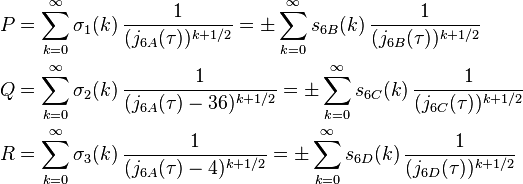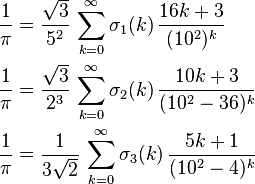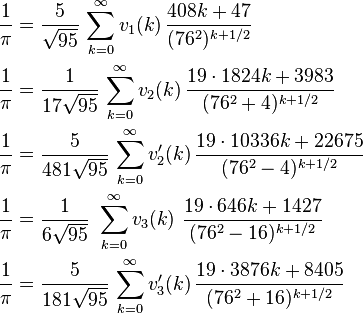Ramanujan–Sato series
In mathematics, a Ramanujan–Sato series[1][2] generalizes Ramanujan’s pi formulas such as,
to the form,
by using other well-defined sequences of integers  obeying a certain recurrence relation, sequences which may be expressed in terms of binomial coefficients
obeying a certain recurrence relation, sequences which may be expressed in terms of binomial coefficients  , and employing modular forms of higher levels.
, and employing modular forms of higher levels.
Ramanujan made the enigmatic remark that there were "corresponding theories", but it was only recently that H.H. Chan and S. Cooper found a general approach that used the underlying modular congruence subgroup  ,[3] while G. Almkvist has experimentally found numerous other examples also with a general method using differential operators.[4]
,[3] while G. Almkvist has experimentally found numerous other examples also with a general method using differential operators.[4]
Levels 1–4A were given by Ramanujan (1917),[5] level 5 by H.H. Chan and S. Cooper (2012),[3] 6A by Chan, Tanigawa, Yang, and Zudilin,[6] 6B by Sato (2002),[7] 6C by H. Chan, S. Chan, and Z. Liu (2004),[1] 6D by H. Chan and H. Verrill (2009),[8] level 7 by S. Cooper (2012),[9] part of level 8 by Almkvist and Guillera (2012),[2] part of level 10 by Y. Yang, and the rest by H.H. Chan and S.Cooper.
The notation jn(τ) is derived from Zagier[10] and Tn refers to the relevant McKay–Thompson series.
Level 1
Examples for levels 1–4 were given by Ramanujan in his 1917 paper. Given  as in the rest of this article. Let,
as in the rest of this article. Let,
with the j-function j(τ), Eisenstein series E4, and Dedekind eta function η(τ). The first expansion is the McKay–Thompson series of class 1A (![]() A007240) with a(0) = 744. Note that, as first noticed by J. McKay, the coefficient of the linear term of j(τ) is exceedingly close to
A007240) with a(0) = 744. Note that, as first noticed by J. McKay, the coefficient of the linear term of j(τ) is exceedingly close to  which is the smallest degree > 1 of the irreducible representations of the Monster group. Similar phenomenon will be observed in the other levels. Define,
which is the smallest degree > 1 of the irreducible representations of the Monster group. Similar phenomenon will be observed in the other levels. Define,
 (
( A001421)
A001421)
Then the two modular functions and sequences are related by,
if the series converges and the sign chosen appropriately, though squaring both sides easily removes the ambiguity. Analogous relationships exist for the higher levels.
Examples:
and  is a fundamental unit. The first belongs to a family of formulas which were rigorously proven by the Chudnovsky brothers in 1989[11]
and later used to calculate 10 trillion digits of π in 2011.[12] The second formula, and the ones for higher levels, was established by H.H. Chan and S. Cooper in 2012.[3]
is a fundamental unit. The first belongs to a family of formulas which were rigorously proven by the Chudnovsky brothers in 1989[11]
and later used to calculate 10 trillion digits of π in 2011.[12] The second formula, and the ones for higher levels, was established by H.H. Chan and S. Cooper in 2012.[3]
Level 2
Using Zagier’s notation[10] for the modular function of level 2,
Note that the coefficient of the linear term of j2A(τ) is one more than  which is the smallest degree > 1 of the irreducible representations of the Baby Monster group. Define,
which is the smallest degree > 1 of the irreducible representations of the Baby Monster group. Define,
 (
( A008977)
A008977)
Then,
if the series converges and the sign chosen appropriately.
Examples:
The first formula, found by Ramanujan and mentioned at the start of the article, belongs to a family proven by D. Bailey and the Borwein brothers in a 1989 paper.[13]
Level 3
Define,
where  is the smallest degree > 1 of the irreducible representations of the Fischer group Fi23 and,
is the smallest degree > 1 of the irreducible representations of the Fischer group Fi23 and,
 (
( A184423)
A184423)
Examples:
Level 4
Define,
where the first is the 24th power of the Weber modular function  . And,
. And,
 (
( A002897)
A002897)
 (
( A036917)
A036917)
Examples:
Level 5
Define,
and,
 (
( A229111)
A229111)
where the first is the product of the central binomial coefficients and the Apery numbers (![]() A005258)[9]
A005258)[9]
Examples:
Level 6
Modular functions
In 2002, Sato[7] established the first results for level > 4. Interestingly, it involved Apéry numbers which were first used to establish the irrationality of  . First, define,
. First, define,
J. Conway and S. Norton showed[14] there are linear relations between the McKay–Thompson series Tn, one of which was,
or using the above eta quotients jn,
σ Sequences
For the modular function j6A, one can associate it with three different sequences. Define the number of 2n-step polygons on a cubic lattice, or the product of the central binomial coefficients  and
and ![]() A002893 as σ1(k),
A002893 as σ1(k),
 (
( A002896)
A002896)
the product of c(k) and (-1)^k ![]() A093388 as σ2(k),
A093388 as σ2(k),
and the product of c(k) and Franel numbers as σ3(k),
 (
( A181418)
A181418)
Each has a companion sequence. Respectively, these are the Apéry numbers,
 (
( A005259)
A005259)
the Domb numbers (unsigned), or the number of 2n-step polygons on a diamond lattice,
 (
( A002895)
A002895)
and the Almkvist-Zudilin numbers,
 (
( A125143)
A125143)
Identities
The modular functions can be related as  where,
where,
if the series converges and the sign chosen appropriately.
Examples
One can use a value for j6A in three ways. For example, starting with,
then,
For the other modular functions,
Level 7
Define
 (
( A183204)
A183204)
and,
Example:
No pi formula has yet been found using j7B.
Level 8
Define,
The expansion of the first is the McKay–Thompson series of class 4B (and is a square root of another function) while the second, if unsigned, is that of class 8A given by the third. Let,
where the first is the product[2] of the central binomial coefficient and a sequence related to an arithmetic-geometric mean (![]() A081085),
A081085),
Examples:
though no pi formula is yet known using j8A(τ).
Level 9
Define,
The expansion of the first is the McKay–Thompson series of class 3C (and related to the cube root of the j-function), while the second is that of class 9A. Let,
where the first is the product of the central binomial coefficients and ![]() A006077 (though with different signs).
A006077 (though with different signs).
Examples:
Level 10
Modular functions
Define,
Just like the level 6, there are also linear relations between these,
or using the above eta quotients jn,
Sequences
Let,
 (
( A005260)
A005260)
their complements,
and,
though closed-forms are not yet known for the last three sequences.
Identities
The modular functions can be related as,[15]
if the series converges. It can also be observed that  where,
where,
Since the exponent has a fractional part, the sign of the square root must be chosen appropriately though it is less an issue when jn is positive.
Examples
Starting with,
then,
though the ones using the complements do not yet have a rigorous proof. A conjectured formula using one of the last three sequences is,
which implies there might be examples for all sequences of level 10.
Level 11
Define the McKay–Thompson series of class 11A,
where,
and,
No closed-form in terms of binomial coefficients is yet known for the sequence but it obeys the recurrence relation,
with initial conditions s(0) = 1, s(1) = 4.
Example:[16]
Higher levels
As pointed out by Cooper,[16] there are analogous sequences for certain higher levels.
See also
References
- ↑ 1.0 1.1 Heng Huat Chan, Song Heng Chan, and Zhiguo Liu, "Domb's numbers and Ramanujan–Sato type series for 1/Pi" (2004)
- ↑ 2.0 2.1 2.2 Gert Almkvist and Jesus Guillera, Ramanujan–Sato Like Series (2012)
- ↑ 3.0 3.1 3.2 H.H. Chan and S. Cooper, "Rational analogues of Ramanujan's series for 1/π", Mathematical Proceedings of the Cambridge Philosophical Society / Volume 153 / Issue 02 / September 2012, pp. 361–383
- ↑ G. Almkvist, Some conjectured formulas for 1/Pi coming from polytopes, K3-surfaces and Moonshine, http://arxiv.org/abs/1211.6563
- ↑ S. Ramanujan, "Modular equations and approximations to pi", Quart. J. Math. (Oxford) 45 (1914)
- ↑ Chan, Tanigawa, Yang, and Zudilin, "New analogues of Clausen’s identities arising from the theory of modular forms" (2011)
- ↑ 7.0 7.1 T. Sato, "Apery numbers and Ramanujan's series for 1/p", Abstract of a talk presented at the Annual meeting of the Mathematical Society of Japan, 2002
- ↑ H. Chan and H. Verrill, "The Apery numbers, the Almkvist–Zudilin Numbers, and new series for 1/π", Advances in Mathematics, Vol 186, 2004
- ↑ 9.0 9.1 S. Cooper, "Sporadic sequences, modular forms and new series for 1/π", Ramanujan Journal 2012
- ↑ 10.0 10.1 D. Zagier, "Traces of Singular Moduli", (p.15-16), http://people.mpim-bonn.mpg.de/zagier/files/tex/TracesSingModuli/fulltext.pdf
- ↑ Chudnovsky, David V.; Chudnovsky, Gregory V. (1989), "The Computation of Classical Constants", Proceedings of the National Academy of Sciences of the United States of America 86 (21): 8178–8182, doi:10.1073/pnas.86.21.8178, ISSN 0027-8424, JSTOR 34831, PMC 298242, PMID 16594075.
- ↑ Yee, Alexander; Kondo, Shigeru (2011), 10 Trillion Digits of Pi: A Case Study of summing Hypergeometric Series to high precision on Multicore Systems, Technical Report, Computer Science Department, University of Illinois.
- ↑ J.M. Borwein, P.B. Borwein and D.H. Bailey, "Ramanujan, modular equations, and approximations to pi; Or how to compute one billion digits of pi", Amer. Math. Monthly, 96 (1989) 201–219
- ↑ J. Conway and S. Norton, "Monstrous Moonshine", p.319, http://citeseerx.ist.psu.edu/viewdoc/download?doi=10.1.1.103.3704&rep=rep1&type=pdf
- ↑ S. Cooper, "Level 10 analogues of Ramanujan’s series for 1/π", Theorem 4.3, p.85, J. Ramanujan Math. Soc. 27, No.1 (2012)
- ↑ 16.0 16.1 S. Cooper, "Ramanujan’s theories of elliptic functions to alternative bases, and beyond", Askey 80 Conference, Dec 2013, http://www.math.umn.edu/~stant001/ASKEYABS/Shaun_Cooper.pdf










































































